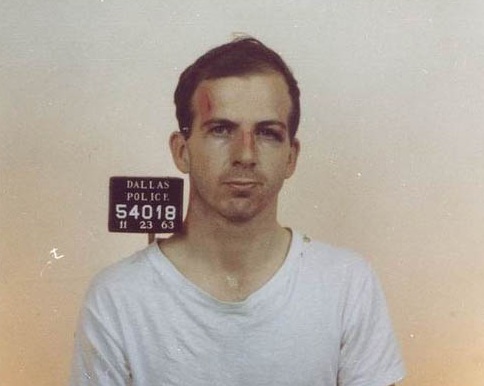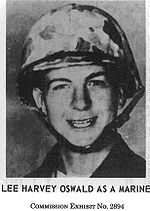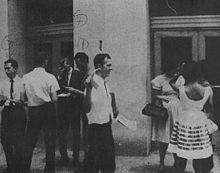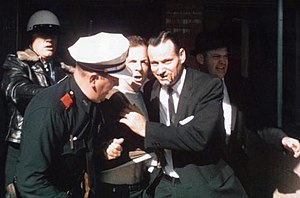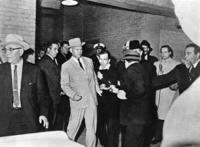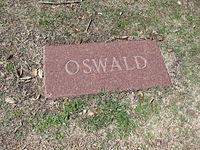| Lee Harvey Oswald (October 18, 1939 � November
24, 1963) was an
American man who, according to four government
investigations,[n
1]
killed
John
F. Kennedy, the
35th President of the United States, using a firearm in
Dallas,
Texas, on
November 22, 1963. A former U.S. Marine who had briefly defected to the Soviet Union, Oswald was initially arrested for the shooting murder of police officer J. D. Tippit, on a Dallas street approximately 40 minutes after Kennedy was shot. Suspected in the assassination of Kennedy as well, Oswald denied involvement in either killing. Two days later, while being transferred from police headquarters to the county jail, Oswald was mortally wounded by nightclub owner Jack Ruby in full view of television cameras broadcasting live. In 1964, the Warren Commission concluded that Oswald acted alone in assassinating Kennedy, a conclusion also reached by prior investigations carried out by the FBI and Dallas Police Department. BiographyChildhoodOswald was born in New Orleans on October 18, 1939,[1] to Robert Edward Lee Oswald, Sr. (New Orleans, Louisiana, March 4, 1896 � New Orleans, August 19, 1939) and Marguerite Frances Claverie (New Orleans, Louisiana, July 19, 1907 � Fort Worth, Texas, January 17, 1981). Oswald had two older siblings � brother Robert Edward Lee Oswald, Jr. and half-brother John Edward Pic.[2] Oswald's father died prior to Oswald's birth, and Marguerite raised her sons alone. When Oswald was two, his mother placed her sons at the Bethlehem Children's Home orphanage in New Orleans for thirteen months, as she was unable to support them.[citation needed] On May 7, 1945, his mother married Edwin Albert Ekdahl (1895�1953) in Fort Worth, Texas; he engaged in numerous extra-marital affairs and filed for divorce in 1948.[citation needed] As a child, Oswald was withdrawn and temperamental.[3] In August 1952, while living with half-brother John Pic, at the time a U.S. Coast Guardsman stationed in New York City, Oswald and Marguerite were asked to leave after Oswald allegedly threatened Pic's wife with a knife and struck their mother, Marguerite.[2][4][5] Charges of truancy, in the Bronx (NYC), led to psychiatric assessment[2] at a juvenile reformatory, the psychiatrist, Dr. Renatus Hartogs, describing Oswald's "vivid fantasy life, turning around the topics of omnipotence and power, through which he tries to compensate for his present shortcomings and frustrations." Finding a "personality pattern disturbance with schizoid features and passive-aggressive tendencies," Dr. Hartogs recommended continued treatment.[6] However, in January 1954, Oswald's mother Marguerite returned with him to New Orleans.[2][7] At the time, there was a question pending before a New York judge as to whether Oswald should be removed from the care of his mother to finish his schooling,[8] although his behavior appeared to improve during his last months in New York.[9][10] In New Orleans, in October 1955, Oswald left the 10th grade after one month.[11] He worked as an office clerk or messenger around New Orleans, rather than attend school. Planning for his enlistment,[2] the family returned to Fort Worth in July 1956, and he re-enrolled in 10th grade for the September session, but quit in October to join the Marines (see below);[2] he never received a high school diploma. By the of age 17, he had resided at 22 different locations and attended 12 different schools.[n 2] Though he had trouble spelling[2] and writing coherently[12] he read voraciously, and by age 15 claimed to be a Marxist, writing in his diary, "I was looking for a key to my environment, and then I discovered socialist literature. I had to dig for my books in the back dusty shelves of libraries." At 16 he wrote to the Socialist Party of America for information on their Young People's Socialist League, saying he had been studying socialist principles for "well over fifteen months."[13] (However, Edward Voebel, "whom the Warren Commission had established was Oswald's closest friend during his teenage years in New Orleans...said that reports that Oswald was already[when?] 'studying Communism' were a 'lot of baloney.' " Voebel said that "Oswald commonly read 'paperback trash.' ")[14][15] Marine CorpsOswald enlisted in the United States Marine Corps on October 24, 1956, just after his seventeenth birthday. He idolized his older brother Robert, and a photograph shows that Lee wore, even after his arrest and handcuffing by Dallas police, Robert's Marines ring.[16] Enlistment may also have been an escape from Oswald's overbearing mother.[17] Oswald's primary training was as a radar operator, a position requiring a security clearance. A May 1957 document states that he was "granted final clearance to handle classified matter up to and including CONFIDENTIAL after careful check of local records had disclosed no derogatory data."[18] In the Aircraft Control and Warning Operator Course he finished seventh in a class of thirty. The course "...included instruction in aircraft surveillance and the use of radar."[19] He was assigned first to Marine Corps Air Station El Toro in July 1957,[20] then to Naval Air Facility Atsugi in Japan in September as part of Marine Air Control Squadron 1. Like all Marines, Oswald was trained and tested in shooting, scoring 212 in December 1956[11] (slightly above the minimum for qualification as a sharpshooter) but in May 1959 scoring only 191[11] (barely earning the lower designation of marksman).[21] Oswald was court-martialed after accidentally shooting himself in the elbow with an unauthorized handgun, then court-martialed again for fighting with a sergeant he thought responsible for his punishment in the shooting matter. He was demoted from private first class to private and briefly imprisoned. He was later punished for a third incident: while on nighttime sentry duty in the Philippines, he inexplicably fired his rifle into the jungle.[22] Slightly built, Oswald was nicknamed Ozzie Rabbit after the cartoon character, or sometimes Oswaldskovich because of his pro-Soviet sentiments. In December 1958 he transferred back to El Toro,[23] where his unit's function "...was to serveil [sic] for aircraft, but basically to train both enlisted men and officers for later assignment overseas." An officer there termed Oswald a "very competent" crew chief.[24] Oswald subscribed on January 2, 1963 to a Communist newspaper, the Daily Worker, and claimed[when?] to have taught himself rudimentary Russian, but in February 1959, he rated "poor" on a Marine proficiency exam in written and spoken Russian.[25] Defection to the Soviet UnionIn October 1959, just before turning 20, Oswald traveled to the Soviet Union, the trip planned well in advance.[when?] Along with his self-taught Russian, he had saved $1,500 of his Marine Corps salary,[n 3] got a hardship discharge (claiming his mother needed care)[11][26] obtained a passport, and submitted several fictional applications to foreign universities in order to obtain a student visa.[clarification needed] Oswald spent two days with his mother in Fort Worth, then embarked by ship from New Orleans on September 20 to Le Havre, France, then immediately proceeded to England. Arriving in Southampton on October 9, he told officials he had $700 and planned to remain in the United Kingdom for one week before proceeding to a school in Switzerland. But on the same day, he flew to Helsinki, where he was issued a Soviet visa on October 14. Oswald left Helsinki by train on the following day, crossed the Soviet border at Vainikkala, and arrived in Moscow on October 16.[27] Almost immediately, Oswald told his Intourist guide of his desire to become a Soviet citizen,[28] but was told on October 21 that his application had been refused. Oswald then inflicted a minor but bloody wound to his left wrist in his hotel room bathtub, after which the Soviets put him under psychiatric observation at a hospital.[29][30] On October 31, Oswald appeared at the United States embassy in Moscow, declaring a desire to renounce his U.S. citizenship.[31][32] John McVickar, an official at the U.S. embassy, felt that Oswald, "...was following a pattern of behavior in which he had been tutored by [a] person or persons unknown...seemed to be using words which he had learned but did not fully understand...in short, it seemed to me that there was a possibility that he had been in contact with others before or during his Marine Corps tour who had guided him and encouraged him in his actions."[33] Oswald told the interviewing officer at the U.S. embassy, Richard Snyder, "...that he had been a radar operator in the Marine Corps and that he had voluntarily stated to unnamed Soviet officials[when?] that as a Soviet citizen he would make known to them such information concerning the Marine Corps and his speciality as he possessed. He intimated that he might know something of special interest."[34] (Such statements led to Oswald's hardship/honorable military discharge being changed to undesirable.)[35] The Associated Press story of the defection of a U.S. Marine to the Soviet Union was reported on the front pages of some newspapers in 1959.[36] Though Oswald had wanted to attend Moscow University, he was sent to Minsk to work as a lathe operator at the Gorizont (Horizon) Electronics Factory, a facility producing radios, televisions, and military and space electronics. He also received a subsidized,[clarification needed] fully furnished studio apartment in a prestigious building and an additional supplement to his factory pay�all in all, an idyllic existence by Soviet working-class standards,[37] although he was under constant surveillance.[38] But Oswald grew bored in Minsk.[39] He wrote in his diary in January 1961: "I am starting to reconsider my desire about staying. The work is drab, the money I get has nowhere to be spent. No nightclubs or bowling alleys, no places of recreation except the trade union dances. I have had enough."[40] Shortly afterwards, Oswald (who had never formally renounced his U.S. citizenship) wrote to the U.S. Embassy in Moscow requesting return of his American passport, and proposing to return to the U.S. if any charges against him would be dropped.[41] (In 1964, Oswald's mother released an audio album, The Oswald Case: Mrs. Marguerite Oswald Reads Lee Harvey Oswald's Letters from Russia, on which she also comments on his letters.)[42] In March 1961, Oswald met Marina Nikolayevna Prusakova, a 19-year-old pharmacology student; they married less than six weeks later in April.[n 4][43] The Oswalds' first child, June, was born on February 15, 1962. On May 24, 1962, Oswald and Marina applied at the U.S. Embassy in Moscow for documents enabling her to immigrate to the U.S. and, on June 1, the U.S. Embassy gave Oswald a repatriation loan of $435.71.[44] Oswald, Marina, and their infant daughter left for the United States, where they received no attention from the press, much to Oswald's disappointment.[clarification needed][45] DallasThe Oswalds soon settled in the Dallas/Fort Worth area, where his mother and brother Robert lived, and Oswald began a memoir on Soviet life. Though he eventually gave up the project, his search for literary feedback put him in touch with anti-Communist Russian �migr�s in the area.[citation needed] In testimony given before the Warren Commission, Alexander Kleinlerer said that the Russian �migr�s sympathized with Marina, while merely tolerating Oswald who they regarded as belligerent and arrogant.[46][n 5] Although the Russian �migr�s eventually abandoned Marina when she made no sign of leaving Oswald,[47] Oswald found an unlikely friend in 51-year-old Russian �migr� George de Mohrenschildt, a well-educated petroleum geologist with intelligence connections.[48] (A native of Russia, de Mohrenschildt told the Warren Commission that Oswald had a "...remarkable fluency in Russian.")[49] Marina, meanwhile, befriended Ruth Paine,[50] a Quaker who was trying to learn Russian, and her husband Michael who worked for Bell Helicopter.[51] (Ruth Paine said that she first met the Oswalds at a party arranged by George de Mohrenschildt.)[52] In July 1962, Oswald was hired by Dallas' Leslie Welding Company; he disliked the work and quit after three months. In October he was hired by the graphic-arts firm of Jaggars-Chiles-Stovall as a photoprint trainee,[n 6] but his inefficiency and rudeness were such that fights threatened to break out,[n 7][clarification needed] and he was seen[by whom?] reading a Russian publication, Krokodil.[n 8] He was fired during the first week of April 1963.[53] He may have used equipment at the firm to forge identification documents.[54][clarification needed] Attempt on life of General WalkerThe Warren Commission concluded that on April 10, 1963, Oswald attempted to kill retired U.S. Major General Edwin Walker,[55] an outspoken anti-communist, segregationist, and member of the John Birch Society who had been relieved of his command in 1962 for distributing right-wing literature to subordinates. His actions in opposition to racial integration at the University of Mississippi led to his arrest on insurrection, seditious conspiracy, and other charges, but a grand jury refused to indict him. Oswald considered Walker the leader of a "fascist organization."[clarification needed][56] In March 1963, Oswald purchased a 6.5 mm caliber Carcano rifle (commonly but improperly called Mannlicher-Carcano) by mail, using the alias A. Hidell.[57] as well as a .38 Smith & Wesson Model 10 revolver by the same method.[58] The Warren Commission concluded that Oswald fired at Walker through a window, from less than 100 feet (30 m) away, as Walker sat at a desk in his home; the bullet struck the windowframe and Walker's only injury was bullet fragments to the forearm. Oswald returned home and told Marina what he had done.[citation needed] (The United States House Select Committee on Assassinations stated that the "evidence strongly suggested" that Oswald carried out the shooting.)[59] At the time, Dallas police had no suspects in the shooting,[60] but Oswald's involvement was suspected within hours of his arrest following the Kennedy assassination.[61] (A note Oswald left for Marina on the night of the attempt, telling her what to do if he did not return, was not found until early December 1963.)[62][63][64] The Walker bullet was too damaged to run conclusive ballistics studies on it,[65] but neutron activation analysis later showed that it was "extremely likely" that it was made by the same manufacturer and for the same rifle make as the two bullets which later struck Kennedy.[n 9] New Orleans
Oswald rented an apartment in this building in
Uptown New Orleans c. May�September 1963
Oswald returned to New Orleans on April 24, 1963.[66] Marina's friend, Ruth Paine, drove her by car from Dallas to join Oswald in New Orleans the next month in May.[67] On May 10, Oswald was hired by the Reily Coffee Company whose owner (William Reily) was a backer of the Crusade to Free Cuba Committee, an anti-Castro organization.[68] Oswald worked as a machinery greaser at Reily, but he was fired in July "...because his work was not satisfactory and because he spent too much time loitering in [Adrian Alba's] garage next door, where he read rifle and hunting magazines."[69][70] (Alba was proprietor of the Crescent City Garage and had a contract to look after a number of cars for the nearby Secret Service and FBI offices.)[71][72][73] On May 26, Oswald wrote to the New York City headquarters of the pro-Castro Fair Play for Cuba Committee, proposing to rent "...a small office at my own expense for the purpose of forming a FPCC branch here in New Orleans."[74] Three days later, the FPCC responded to Oswald's letter advising against opening a New Orleans office "at least not ... at the very beginning."[75] In a follow-up letter, Oswald replied, "Against your advice, I have decided to take an office from the very beginning."[76] As the sole member of the New Orleans chapter of the Fair Play for Cuba Committee, Oswald ordered the following items from a local printer: 500 application forms, 300 membership cards, and 1,000 leaflets with the heading, "Hands Off Cuba."[77] According to Lee Oswald's wife Marina, Lee told her to sign the name "A.J. Hidell" as chapter president on his membership card.[78] On August 5th and 6th, according to anti-Castro militant Carlos Bringuier, Oswald visited him at a store he owned in New Orleans. Bringuier was the New Orleans delegate for the Student Revolutionary Directorate (DRE), an anti-Castro organization. Bringuier would later tell the Warren Commission that he believed Oswald's visits were an attempt by Oswald to infiltrate his group.[79] On August 9, Oswald turned up in downtown New Orleans handing out pro-Castro leaflets. Bringuier confronted Oswald, claiming he was tipped off about Oswald's leafleting by a friend. A scuffle ensued and Oswald, Bringuier, and two of Bringuier's friends were arrested for disturbing the peace.[80] Before leaving the police station, Oswald asked to speak with an FBI agent. Agent John Quigley arrived and spent over an hour talking to Oswald.[81] A week later, on August 16, Oswald again passed out Fair Play for Cuba leaflets with two hired helpers, this time in front of the International Trade Mart. The incident was filmed by WDSU -- the local TV station.[82] The next day, Oswald was interviewed by WDSU radio commentator William Stuckey, who probed Oswald's background.[83][84] A few days later, Oswald accepted Stuckey's invitation to take part in a radio debate with Carlos Bringuier and Bringuier's associate Edward Butler, head of the right-wing Information Council of the Americas (INCA).[85][86] One of Oswald's Fair Play for Cuba leaflets had the address "544 Camp Street" hand-stamped on it, apparently by Oswald himself.[87] The address was in the "Newman Building" which, from October 1961 to February 1962, housed the militant anti-Castro group, the Cuban Revolutionary Council.[88][89] Around the corner but located in the same building, with a different entrance, was the address 531 Lafayette Street -- the address of "Guy Banister Associates", a private detective agency run by former FBI agent Guy Banister. Banister's office was involved in anti-Castro and intelligence activities in the New Orleans area.[90][91] In the late-1970s, the House Select Committee on Assassinations (HSCA) investigated the possible relationship of Oswald to Banister's office. While the committee was unable to interview Guy Banister (who died in 1964), the committee did interview his brother Ross Banister. Ross "...told the committee that his brother had mentioned seeing Oswald hand out Fair Play for Cuba literature on one occasion. Ross theorized that Oswald had used the 544 Camp Street address on his literature to embarrass Guy."[92] Guy Banister's secretary, Delphine Roberts, told author Anthony Summers that she saw Oswald at Banister's office, and that he filled out one of Banister's "agent" application forms. She said, "Oswald came back a number of times. He seemed to be on familiar terms with Banister and with the office."[93] The House Select Committee on Assassinations investigated Roberts' claims and said that "because of contradictions in Roberts' statements to the committee and lack of independent corroboration of many of her statements, the reliability of her statements could not be determined."[94] Oswald's mid-1963 New Orleans activities were later investigated by New Orleans District Attorney Jim Garrison, as part of his prosecution of Clay Shaw in 1969. Garrison was particularly interested in an associate of Guy Banister -- a man named David Ferrie[95] and his possible connection to Oswald, which Ferrie himself denied.[96] Ferrie died before Garrison could complete his investigation.[97] In 1993, the PBS television program Frontline obtained a photograph, taken eight years before the assassination, showing Oswald and Ferrie at a Civil Air Patrol cookout with other C.A.P. cadets.[clarification needed][98]
Further information:
David Ferrie
Further information:
Trial of Clay Shaw
MexicoMarina's friend, Ruth Paine, transported Marina by car from New Orleans to Dallas on September 23, 1963.[99][100] Oswald stayed in New Orleans at least two more days to collect a $33 unemployment check. It is uncertain when he left New Orleans: he is next known to have boarded a bus in Houston�bound for the Mexican border, rather than Dallas, and telling other passengers he planned to travel to Cuba via Mexico.[101] In Mexico City, he applied for a transit visa at the Cuban Embassy,[102] claiming he wanted to visit Cuba on his way back to the Soviet Union. Cuban officials insisted Oswald would need Soviet approval, but he was unable to get prompt co-operation from that embassy. After five days of shuttling between consulates, a heated argument with the Cuban consul, impassioned pleas to KGB agents, and at least some CIA scrutiny,[103] Oswald was told by the Cuban consul that he was disinclined to approve the visa, saying "a person like [Oswald] in place of aiding the Cuban Revolution, was doing it harm."[104] Nonetheless, on October 18, the Cuban embassy indeed approved the visa, but Oswald did not in fact embark for Cuba.[citation needed] (Eleven days before the assassination of Kennedy, Oswald wrote to the Soviet embassy in Washington, D.C., saying, "Had I been able to reach the Soviet Embassy in Havana as planned, the embassy there would have had time to complete our business.")[clarification needed][105][106] Return to Dallas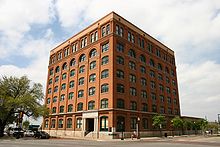
Texas Schoolbook Depository, where Oswald
was an employee
Instead, on October 3, Oswald left by bus for Dallas. According to the Warren Commission, on October 14, a neighbor told Ruth Paine that there was a job opening at the Texas School Book Depository. Mrs. Paine informed Oswald who was interviewed at the Depository and was hired there on October 16.[107] Oswald's supervisor, Roy Truly, said that Oswald "did a good day's work" and was an above average employee.[108] During the week, Oswald stayed in a Dallas rooming house (under the name O.H. Lee),[109] but he spent his weekends with Marina at the Paine home in Irving. Oswald did not drive, but commuted to and from Dallas on Mondays and Fridays with a neighbor, Wesley Buell Frazier, who worked at the Book Depository. On October 20, the Oswalds' second daughter was born. FBI agents twice visited the Paine home in early November, when Oswald was not present, looking for information on Marina, whom they suspected of being a Soviet agent.[110] Oswald visited the Dallas FBI office about 7 to 10 days before the assassination, asking to see Special Agent James Hosty; told Hosty was unavailable, Oswald left a note that, according to the receptionist, read: "Let this be a warning. I will blow up the FBI and the Dallas Police Department if you don�t stop bothering my wife. Signed - Lee Harvey Oswald." The note contained some sort of threat, but accounts varied widely as to whether Oswald threatened to "blow up the FBI" or merely "report this to higher authorities" [111] Hosty reported to the Warren Commision under testimony, the note said "if you have anything you want to learn about me, come talk to me directly. If you don't cease bothering my wife, I will take the appropriate action and report this to the proper authorities." According to Hosty, two days after the assassination, Dallas FBI Special Agent-in-Charge J. Gordon Shanklin ordered Hosty to destroy the note. [112][113] In the days before Kennedy's arrival, several newspapers described the route of the presidential motorcade as passing the Book Depository.[114] On November 21 (a Thursday) Oswald asked his co-worker Frazier for an unusual mid-week lift back to Irving, saying he had to pick up some curtain rods. The next morning (Friday) he returned to Dallas with Frazier; he left behind $170 and his wedding ring,[115] but took with him a long paper bag.[116] He was last seen by a co-worker on the sixth floor of the Depository about 30 minutes before the assassination.[clarification needed][n 10] Shootings of Kennedy and Tippit
Main article:
John F. Kennedy assassination
Further information:
Lone gunman theory
According to government investigations (including that of the Warren Commission) as Kennedy's motorcade passed through Dallas's Dealey Plaza about 12:30 p.m. on November 22, Oswald fired from a window on the sixth floor of the Book Depository, killing the President and seriously wounding Texas Governor John Connally. Bystander James Tague received a minor facial injury. According to the Warren Commission, immediately after firing Oswald hid the rifle behind some boxes and descended the rear stairwell. About ninety seconds after the shooting, in the second-floor lunchroom he encountered a police officer accompanied by Oswald's supervisor; the officer let Oswald pass after the supervisor identified him as an employee. (According to the officer, Oswald was drinking a soda and did not appear to be nervous or out of breath.) Oswald crossed to the front staircase, and left the building just before police sealed it off. The supervisor later pointed out to officers that Oswald was the only employee to absent himself after the assassination.[117][118] At about 12:40 p.m. Oswald boarded a city bus but (probably due to heavy traffic) he requested a transfer from the driver and got off two blocks later.[119] He took a taxicab to his rooming house, at 1026 North Beckley, which he entered about 1:00 p.m., "walking pretty fast" according to his housekeeper.[120] He soon left wearing a jacket, and was last seen by the housekeeper by the stop for a bus route heading back to downtown Dallas.[121] About four-fifths of a mile (1.3 km) away, Patrolman J. D. Tippit pulled alongside Oswald on a residential street and spoke to him through a window.[122] At approximately 1:11�1:14 p.m.,[n 11] Tippit exited his car and was immediately struck and killed by four shots.[123][124] Numerous witnesses heard the shots and saw a man flee the scene holding a revolver.[125][n 12] Four cartridge cases found at the scene were identified by expert witnesses before the Warren Commission and the House Select Committee as having been fired from the revolver later found in Oswald's possession, to the exclusion of all other weapons.[126][127] CaptureMinutes later, Oswald was seen "ducking into" the entrance alcove of a shoe store, apparently avoiding passing police cars. Soon after, the store's manager saw Oswald slip into the nearby Texas Theater without paying.[128] He alerted the theater's ticket clerk, who telephoned police.[129] As police arrived, the house lights were brought up as the store manager pointed out Oswald sitting near the rear. Oswald appeared to surrender (saying, "Well, it is all over now") but then struck an officer; he was disarmed after a struggle.[130] As he was led from the theater, Oswald shouted he was a victim of police brutality.[131] At about 2 p.m., Oswald arrived at the Police Department building, where he was questioned by Detective Jim Leavelle about the shooting of Officer Tippit. When Captain J. W. Fritz heard Oswald's name, he recognized it as that of the Book Depository employee who was reported missing and was already a suspect in the assassination.[132][133] Oswald was booked[when?] for both murders, and by the end of the night he had been arraigned as well.[134] Soon after his capture Oswald encountered reporters in a hallway, declaring "I didn't shoot anyone" and "They're taking me in because of the fact I lived in the Soviet Union. I'm just a patsy!" Later, at an arranged press meeting, a reporter asked, "Did you kill the President?" and Oswald, who by that time had been advised of the charge of murdering Tippit, but not yet arraigned in Kennedy's death, answered "No, I have not been charged with that. In fact, nobody has said that to me yet. The first thing I heard about it was when the newspaper reporters in the hall asked me that question." As he was led from the room, "What did you do in the USSR?" was called out, and "How did you hurt your eye?"; Oswald answered, "A policeman hit me."[135][136][137] Police interrogation
Fake selective service (draft) card in the name
of Alek James Hidell, found on Oswald
when arrested. A.Hidell was the name used
on both envelope and order slip to buy the
murder weapon (see CE 773),[138]
and A. J. Hidell was the alternate name
on the New Orleans post office box rented June
11, 1963, by Oswald.[139]
Both the murder weapon and the pistol in
Oswald's possession at arrest had earlier been
shipped (at separate times) to Oswald's Dallas
P.O. Box 2915, as ordered by "A. J. Hidell".[140]
Oswald was interrogated several times during his two days at Dallas Police Headquarters. He denied killing Kennedy and Tippit, denied owning a rifle, said two photographs of him holding a rifle and a pistol were fakes, denied telling his co-worker he wanted a ride to Irving to get curtain rods for his apartment, and denied carrying a long heavy package to work the morning of the assassination. The Warren Commission also noted that Oswald denied knowing an A. J. Hidell, and when shown a forged Selective Service card bearing that name in his possession when arrested, refused to answer any questions concerning it, saying "...you have the card yourself and you know as much about it as I do." [141] The Warren Commission noted that this "spurious" card bore the name of Alek James Hidell. [142] During his first interrogation on Friday, November 22, Oswald was asked to account for himself at the time the President was shot. Oswald said he ate lunch in the Depository's first-floor lunchroom, then went to the second floor for a Coca-Cola, where he encountered the policeman.[143] During his last interrogation on November 24, Oswald was asked again where he was at the time of the shooting; he said he was working on an upper floor when it occurred, then went downstairs where he encountered the officer.[144] Oswald asked for legal representation several times while being interrogated, as well as in encounters with reporters. But when representatives of the Dallas Bar Association met with him in his cell on Saturday, he declined their services, saying he wanted to be represented by John Abt, chief counsel to the Communist Party USA, or by lawyers associated with the American Civil Liberties Union.[145][146] Both Oswald and Ruth Paine tried to reach Abt by telephone several times Saturday and Sunday,[147][148] but Abt was away for the weekend.[149] Oswald also declined his brother Robert's offer on Saturday to obtain a local attorney.[150] Death
See also:
Jack
Ruby
On Sunday, November 24 Oswald was being led through the basement of Dallas Police Headquarters preparatory to his transfer to the county jail when, at 11:21 a.m., Dallas nightclub operator Jack Ruby stepped from the crowd and shot Oswald in the abdomen. Oswald died at 1:07 p.m. at Parkland Memorial Hospital�the same hospital where Kennedy had died two days earlier.[109] A network television camera, there to cover the transfer, was broadcasting live at the time, and millions thereby witnessed the shooting as it happened.[151] The event was also captured in a well-known photograph (see right). Ruby later said he had been distraught over Kennedy's death, though some have hypothesized it was part of a conspiracy.[152] After autopsy, Oswald[153] was buried in Fort Worth's Rose Hill Memorial Burial Park.[154][155] A marker inscribed simply Oswald replaces the stolen original tombstone, which gave Oswald's full name and birth�death dates.[156] Official investigationsWarren CommissionThe Warren Commission, created by President Lyndon B. Johnson to investigate the assassination, concluded that Oswald acted alone in assassinating Kennedy (this view is known as the lone gunman theory). The Commission could not ascribe any one motive or group of motives to Oswald's actions:
The proceedings of the commission were closed, though not secret, and about 3% of its files have yet to be released to the public, which has continued to provoke speculation among researchers.[n 13] Ramsey Clark PanelIn 1968, the Ramsey Clark Panel examined various photographs, X-ray films, documents, and other evidence, concluding that Kennedy was struck by two bullets fired from above and behind him, one of which traversed the base of the neck on the right side without striking bone, and the other of which entered the skull from behind and destroyed its right side.[158] House Select Committee
Main article:
United States House Select Committee on Assassinations
Further information:
Dictabelt evidence relating to the assassination of John
F. Kennedy
In 1979, after a review of the evidence and of prior investigations, the United States House Select Committee on Assassinations was preparing to issue[citation needed] a finding that Oswald had acted alone in killing Kennedy. However, late in the Committee's proceedings a Dictabelt was introduced,[clarification needed] purportedly recording sounds heard in Dealey Plaza before, during and after the shots were fired. After submitting the Dictabelt to acoustic analysis, the Committee revised its findings to assert a "high probability that two gunmen fired" at Kennedy and that Kennedy "was probably assassinated as the result of a conspiracy." Although the Committee was "unable to identify the other gunman or the extent of the conspiracy," it made a number of further findings regarding the likelihood or unlikelihood that particular groups, named in the findings, were involved.[159] The Dictabelt evidence has been questioned, some believing it is not a recording of the assassination at all.[160] The staff director and chief counsel for the Committee, G. Robert Blakey, told ABC News[when?] that at least 20 persons heard a shot from the grassy knoll, and that a conspiracy was established by both the witness testimony and acoustic evidence, but in 2004 he expressed less confidence.[161] Officer H.B. McLain, from whose motorcycle radio the HSCA acoustic experts said the Dictabelt evidence came,[162][163] has repeatedly stated that he was not yet in Dealey Plaza at the time of the assassination.[164] McLain asked the Committee, "�If it was my radio on my motorcycle, why did it not record the revving up at high speed plus my siren when we immediately took off for Parkland Hospital?��[165] In 1982, a group of twelve scientists appointed by the National Academy of Sciences (NAS), led by Norman Ramsey, concluded that the acoustic evidence submitted to the HSCA was "seriously flawed."[citation needed] Subsequently, a 2001 article in Science and Justice, the journal of Britain's Forensic Science Society, said that the NAS investigation was itself flawed and concluded with a 96.3 percent certainty that there were at least two gunmen firing at President Kennedy and that at least one shot came from the grassy knoll.[166] Commenting on the British study, G. Robert Blakey said: "This is an honest, careful scientific examination of everything we did, with all the appropriate statistical checks."[167] Other investigations and dissenting theories
Main article:
Kennedy assassination conspiracy theories
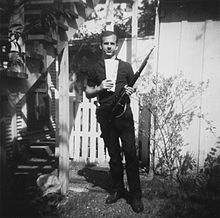
Image CE-133A, one of three known "backyard
photos," the same image sent by Oswald (as a
first-generation copy) to
George de Mohrenschildt in April, 1963,
dated and signed on the back. Oswald holds a
Carcano rifle, with markings matching those on
the rifle found in the Book Depository after the
assassination.
Critics have not accepted the conclusions of the Warren Commission and have proposed a number of other theories, such as that Oswald conspired with others, or was not involved at all and was framed. In October 1981, with Marina's support, Oswald's grave was opened to test a theory propounded by writer Michael Eddowes: that during Oswald's stay in the Soviet Union he was replaced with a Soviet double; that it was this double, not Oswald, who killed Kennedy and who is buried in Oswald's grave; and that the exhumed remains would therefore not exhibit a surgical scar Oswald was known to carry. However, dental records positively identified the exhumed corpse as Oswald's, and the scar was present.[n 14] Fictional trialsSeveral films[168] have fictionalized a trial of Oswald. In 1988, a 21-hour unscripted mock trial was "held" on television, argued by actual lawyers before an actual judge,[169] with unscripted testimony from surviving witnesses to the events surrounding the assassination; the mock jury returned a verdict of guilty. Author Gerald Posner (whose book Case Closed endorses the Warren Commission's conclusions) participated[clarification needed] in a shorter, scripted mock trial for television.[citation needed] Backyard photos
Main article:
John F. Kennedy assassination rifle
The "backyard photos", taken by Marina Oswald probably around March 31, 1963 using a camera belonging to Oswald, show Oswald holding two Marxist newspapers�The Militant and The Worker�and a rifle, and wearing a pistol in a holster.[170] Shown the pictures after his arrest, Oswald insisted they were forgeries,[171] but Marina testified in 1964 that she had taken the photographs at Oswald's request�[172] testimony she reaffirmed repeatedly over the decades.[n 15] These photos were labelled CE 133-A and CE 133-B. CE 133-A shows the rifle in Oswald's left hand and newsletters in front of his chest in the other, while the rifle is held with the right hand in CE 133-B. Oswald's mother testified that on the day after the assassination she and Marina destroyed another photograph with Oswald holding the rifle with both hands over his head, with "To my daughter June" written on it.[173] The HSCA obtained another first generation print (from CE 133-A) on April 1, 1977 from the widow of George de Mohrenschildt. The words "Hunter of fascists � ha ha ha!" written in block Russian were on the back. Also in English were added in script: "To my friend George, Lee Oswald, 5/IV/63 [April 5, 1963]"[174] Handwriting experts for the HSCA concluded the English inscription and signature were by Oswald. After two original photos, one negative and one first-generation copy had been found, the Senate Intelligence Committee located (in 1976) a third backyard photo (CE 133-C) showing Oswald with newspapers held away from his body in his right hand). A test photo by the Dallas Police of a stand-in in the identical pose was released with the Warren Commission evidence in 1964,[175] but it is not known why CE 133-C itself was not publicly acknowledged until a print was found in 1975 amongst the effects of a deceased Dallas police officer.[176] These photos, widely recognized as some of the most significant evidence against Oswald, have been subjected to rigorous analysis.[177] Photographic experts consulted by the HSCA concluded they were genuine,[178] answering twenty-one points raised by critics.[179] Marina Oswald has always maintained she took the photos herself, and the 1963 de Mohrenschildt print bearing Oswald's signature clearly indicate they existed before the assassination. Nonetheless, some continue to contest their authenticity.[180] After digitally analyzing the photograph of Oswald holding the rifle and paper, computer scientist Hany Farid concluded[181] that it "almost certainly was not altered."[182] Notes
References
Further reading
External links
|


